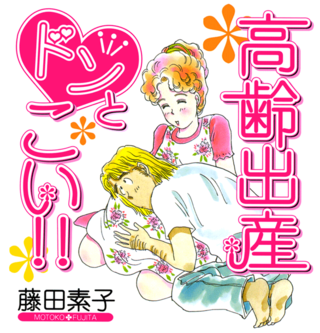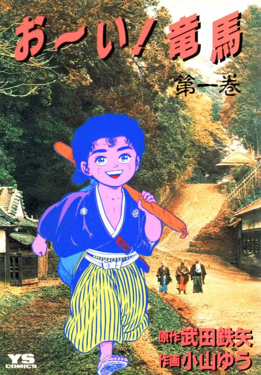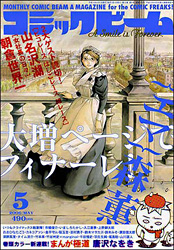Furigana is a Japanese reading aid consisting of smaller kana printed either above or next to kanji or other characters to indicate their pronunciation. It is one type of ruby text. Furigana is also known as yomigana (読み仮名) and rubi in Japanese. In modern Japanese, it is usually used to gloss rare kanji, to clarify rare, nonstandard or ambiguous kanji readings, or in children's or learners' materials. Before the post-World War II script reforms, it was more widespread.

Manga are comics or graphic novels originating from Japan. Most manga conform to a style developed in Japan in the late 19th century, and the form has a long history in earlier Japanese art. The term manga is used in Japan to refer to both comics and cartooning. Outside of Japan, the word is typically used to refer to comics originally published in Japan.
Shōnen manga is an editorial category of Japanese comics targeting an audience of adolescent boys. It is, along with shōjo manga, seinen manga, and josei manga, one of the primary editorial categories of manga. Shōnen manga is traditionally published in dedicated manga magazines that exclusively target the shōnen demographic group.

Josei manga, also known as ladies' comics (レディースコミック) and its abbreviation redikomi , is an editorial category of Japanese comics that emerged in the 1980s. In a strict sense, josei refers to manga marketed to an audience of adult women, contrasting shōjo manga, which is marketed to an audience of girls and young adult women. In practice, the distinction between shōjo and josei is often tenuous; while the two were initially divergent categories, many manga works exhibit narrative and stylistic traits associated with both shōjo and josei manga. This distinction is further complicated by a third manga editorial category, young ladies (ヤングレディース), which emerged in the late 1980s as an intermediate category between shōjo and josei.

Weekly Shōnen Jump is a weekly shōnen manga anthology published in Japan by Shueisha under the Jump line of magazines. The manga series within the magazine consist of many action scenes and a fair amount of comedy. Chapters of the series that run in Weekly Shōnen Jump are collected and published in tankōbon volumes under the Jump Comics imprint every two to three months. It is one of the longest-running manga magazines, with the first issue being released with a cover date of August 1, 1968.
Mitsuru Adachi is a Japanese manga artist. After graduating from Gunma Prefectural Maebashi Commercial High School in 1969, Adachi worked as an assistant for Isami Ishii. He made his manga debut in 1970 with Kieta Bakuon, based on a manga originally created by Satoru Ozawa. Kieta was published in Deluxe Shōnen Sunday.

Shogakukan Inc. is a Japanese publisher of comics, magazines, light novels, dictionaries, literature, non-fiction, home media, and other media in Japan.
Children's manga and children's anime refer to manga and anime directed towards children. These series are usually moralistic, often educating children about staying in the right path in life. Each chapter is usually a self-contained story.

Weekly Shōnen Magazine is a weekly shōnen manga magazine published on Wednesdays in Japan by Kodansha, first published on March 17, 1959. The magazine is mainly read by an older audience, with a significant portion of its readership falling under the male high school or college student demographic. According to circulation figures accumulated by the Japanese Magazine Publishers Association, the magazine's circulation has dropped in every quarter since records were first collected in April–June 2008. This is, however, not an isolated occurrence as digital media continues to be on the rise.

Manga, in the sense of narrative multi-panel cartoons made in Japan, originated from Euro-American-style cartoons featured in late 19th-century Japanese publications. The form of manga as speech-balloon-based comics more specifically originated from translations of American comic strips in the 1920s; several early examples of such manga read left-to-right, with the longest-running pre-1945 manga being the Japanese translation of the American comic strip Bringing Up Father. The term manga first came into usage in the late 18th century, though it only came to refer to various forms of cartooning in the 1890s and did not become a common word until around 1920.

Oi! Ryōma, also known as Rainbow Samurai, is a Japanese manga series written by Tetsuya Takeda and illustrated by Yū Koyama. It is a comical and serious account mixing history and fiction of the life of the Bakumatsu period leader Sakamoto Ryōma. It was serialized in Shogakukan's shōnen manga magazine Shōnen Big Comic (1986–1987) and seinen manga magazine Weekly Young Sunday (1987–1996), with its chapters collected in 23 tankōbon volumes. It was adapted into a 39-episode anime television series by Nippon Herald Films and Animation 21 and broadcast on NHK from April 1992 to March 1993. The manga has had over 15 million copies in circulation.

Comic Beam (コミックビーム) is a Japanese seinen manga magazine published by Enterbrain on a monthly basis since November 1995. In 2006, it had a circulation of 25,000.
Gutsoon! Entertainment, Inc. was a publisher of English translated manga. The company, headquartered in Encino, Los Angeles, served as the US subsidiary of Coamix, which was founded by Nobuhiko Horie and manga artist Tsukasa Hojo.

Super Jump, was a biweekly manga anthology published by Shueisha under the Jump line of magazines. Released in Japan on December 20, 1986, the magazine provided serialized chapters of various seinen manga series. The manga series were published under the Jump Comics Deluxe imprint.

Shonen Jump, officially stylized SHONEN JUMP and abbreviated SJ, was a shōnen manga anthology published in North America by Viz Media. It debuted in November 2002 with the first issue having a January 2003 cover date. Based on Shueisha's popular Japanese magazine Weekly Shōnen Jump, Shonen Jump was retooled for English readers and the American audience, including changing it from a weekly publication to a monthly one. It featured serialized chapters from different manga series and articles on Japanese language and culture, as well as manga, anime, video games, and figurines. The premiere issue of Shonen Jump also introduced the first official English translations of One Piece, Sand Land, Yu-Gi-Oh!, YuYu Hakusho, and Naruto.
Jump, also known as Jump Comics, is a line of manga anthologies created by Shueisha. It began with Shōnen Jump manga anthology in 1968, later renamed Weekly Shōnen Jump. The origin of the name is unknown. The Jump anthologies are primarily intended for male audiences, although the Weekly Shōnen Jump magazine has also been popular with the female demographic. Along with the line of manga anthologies, Shōnen Jump also includes a crossover media franchise, where there have been various Shōnen Jump themed crossover anime and video games, which bring together various Shōnen Jump manga characters.

Young Comic is a long-running Japanese seinen manga magazine started in 1967 as a magazine for adult men competing with titles like Manga Action and Big Comic. Today it targets a young adult male audience with contents tilting heavily toward sex, nudity, and gratuitous fan service. It is published monthly by Shōnen Gahōsha as a sister publication to Young King. Its circulation in 2008 was reported at 112,000 copies.

Shueisha Inc. is a Japanese publishing company headquartered in Chiyoda, Tokyo, Japan. Shueisha is the largest publishing company in Japan. It was established in 1925 as the entertainment-related publishing division of Japanese publisher Shogakukan. The following year, Shueisha became a separate, independent company.
Sports manga is a genre of Japanese manga and anime that focuses on stories involving sports and other athletic and competitive pursuits. Though Japanese animated works depicting sports were released as early as the 1920s, sports manga did not emerge as a discrete category until the early 1950s. The genre achieved prominence in the context of the post-war occupation of Japan, and gained significant visibility during and subsequent to the 1964 Summer Olympics in Tokyo. Noted as among the most popular genres of manga and anime, sports manga is credited with introducing new sports to Japan, and popularizing existing sports.













